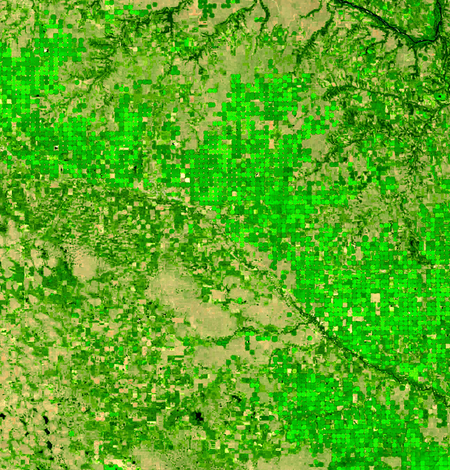Latest In Landsat February 2025 - Vol. 4 | Issue 2
Landsat starts off 2025 capturing dramatic imagery—fire scars draping over Los Angeles communities in the West and snow cover blanketing south Texas. If a picture is worth a thousand words, an image representing an archive milestone will give any of them a run for their money! Learn more about these unique images, and how to apply for membership on the next Landsat Science Team in this newsletter.
Landsat satellites capture valuable views of fires in California
Fires that started across the greater Los Angeles area in early January have burned nearly 50,000 acres, destroyed over 15,000 structures and prompted evacuation orders and warnings for as many as 200,000 residents. Exceptionally dry conditions, coupled with strong Santa Ana winds, fueled the Palisades, Eaton and Hughes fires. At the time of this issue, the fires are now nearly fully contained.
Landsat satellites captured imagery of the area on January 6th, the day before the fires began, and again on January 14th. A band combination of shortwave infrared, near infrared, and red bands was used to highlight the burn scars, or the reddish-brown areas, in the bottom image. Burned areas have high shortwave infrared values and low near-infrared values, whereas healthy vegetation has low shortwave values and high near-infrared values. The spectral contrast between the healthy (unburned) and unhealthy (burned) vegetation makes the burn scars distinct and pronounced.

View the Landsat 8 image.
View the Landsat 9 image.
View this slider image to further compare the images.
By observing before, during, and after conditions with Landsat data, fire scientists, land managers, and community planners can assess the extent of damage and track recovery over time. Landsat’s long-term record also offers valuable insights into fire frequency, severity, and the resilience of ecosystems. These insights contribute to a better understanding of wildfire dynamics and aid in informing effective management strategies.
What do a large rare Earth element mine, a sprawling desert, volcanic cones and lava tubes, and irrigated farmland have in common?

We found all these land features (and more!) on this single Landsat image!
In late 2024, Landsat 9 captured data used to create this image to highlight the milestone of reaching 12 million Level-1 products in the Landsat archive at the USGS EROS Center (visit the related News article to learn more about this milestone).
This image shows a portion of the desert Southwest in the United States, an area that consists of many different landscapes — including agriculture, volcanic cones and lava tubes, mining, and mountainous areas reaching up from the desert.
Click the link below to access a video and travel around the image with us to see what we uncovered!
USGS EROS Image of the Week: Landsat's 12 Millionth Image
Other Interesting News
USGS Invites Federal and International Partners to Join the Next Landsat Science Team
The USGS, in partnership with NASA, is calling for applications to staff the next Landsat Science Team to serve a 5-year term from 2025 to 2030.
International Partners Discuss Landsat Next, Evolving Technologies
The USGS’s International Cooperators team held the Landsat Ground Station Operators Working Group (LGSOWG) #52 meeting in Canberra, Australia late last year.
Check out these great images posted to our social media channels in January!
Landsat Collection 2 Level-2 Science Products
The USGS provides research-quality, applications-ready Landsat Level-2 and Level-3 science products to support an array of land surface change studies. Collection 2 Level-2 scene-based science products include Surface Reflectance, Surface Temperature, Surface Reflectance-Derived Spectral Indices, and Provisional Aquatic Reflectance.Surface Reflectance measures the fraction of incoming solar…
Landsat 8 Image of Snowfall in Houston, Texas
On Tuesday, January 21, 2025, Winter Storm Enzo brought an exceptionally rare snowfall to the Greater Houston metro area of Texas. The National Weather Service reported 5.5 inches (14 cm) in Baytown, a city located east of Houston on the northern shore of Galveston Bay. Other cities and locales received upwards of 3 to 4 inches (7.6 to 10.2 cm). Schools, government offices, and airports were…
Landsat 8 Image of the Salt Dome Islands of Louisiana
Louisiana is home to numerous salt domes, including the five distinct coastal salt dome islands that can be found in the southern part of the state near the Gulf of America. Formed by the upward pressure of ancient salt deposits, these hills rise above the surrounding marshes and coastal plains of Louisiana. The five islands from northwest to southeast are Jefferson Island, Avery Island, Weeks…
Learn more about the science at EROS, and how Landsat benefits your State!
-
Landsat Benefits, State By State Landsat Benefits, State By State
Orbiting 438 miles above the Earth, Landsat satellites capture imagery of the face of our planet. Scientists, land and water resource managers and more use the data to study and monitor how the land is changing. From mapping wildfires, to monitoring urban growth and the quality of water sources, Landsat data return billions of dollars in economic value to all 50 United States.
-
Science Science
EROS scientists study how the land changes and impacts ecosystems, economics, and everyday life. Our science uses satellite data to track land change, support disaster response, and guide resource management. With five decades of Landsat observations and other Earth data, EROS research helps scientists, policymakers, and the public better understand our planet and make informed decisions.
-
Education Education
The resources at USGS EROS Center are not just for professional scientists! Everyone is welcome to study how land changes over time through satellite imagery. Here, you will find kid-friendly lessons and games, dazzling snapshots of our planet, and the latest news about EROS. You can also learn about onsite options including tours and our one-of-a-kind library.
Do you have questions about Landsat? Check these pages to learn more!
-
Landsat Frequently Asked Questions Landsat Frequently Asked Questions
This page lists commonly asked questions pertaining to the Landsat satellite missions, the science behind maintaining high quality Landsat data, and what products are available - and how to download them.
-
Connect Connect
Access the information on this page to learn more about Landsat, access our social media platforms, or contact us with questions you have about the Landsat missions, the available science products, and how to access Landsat data!













